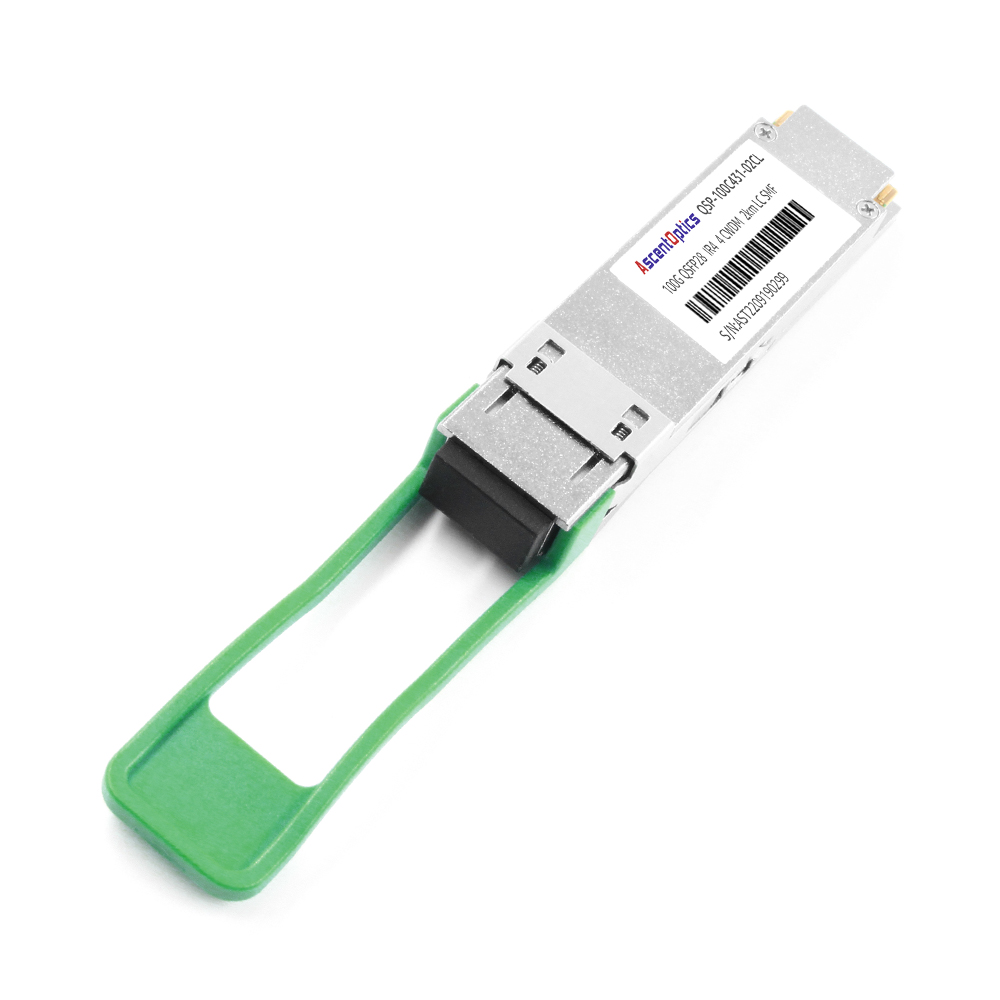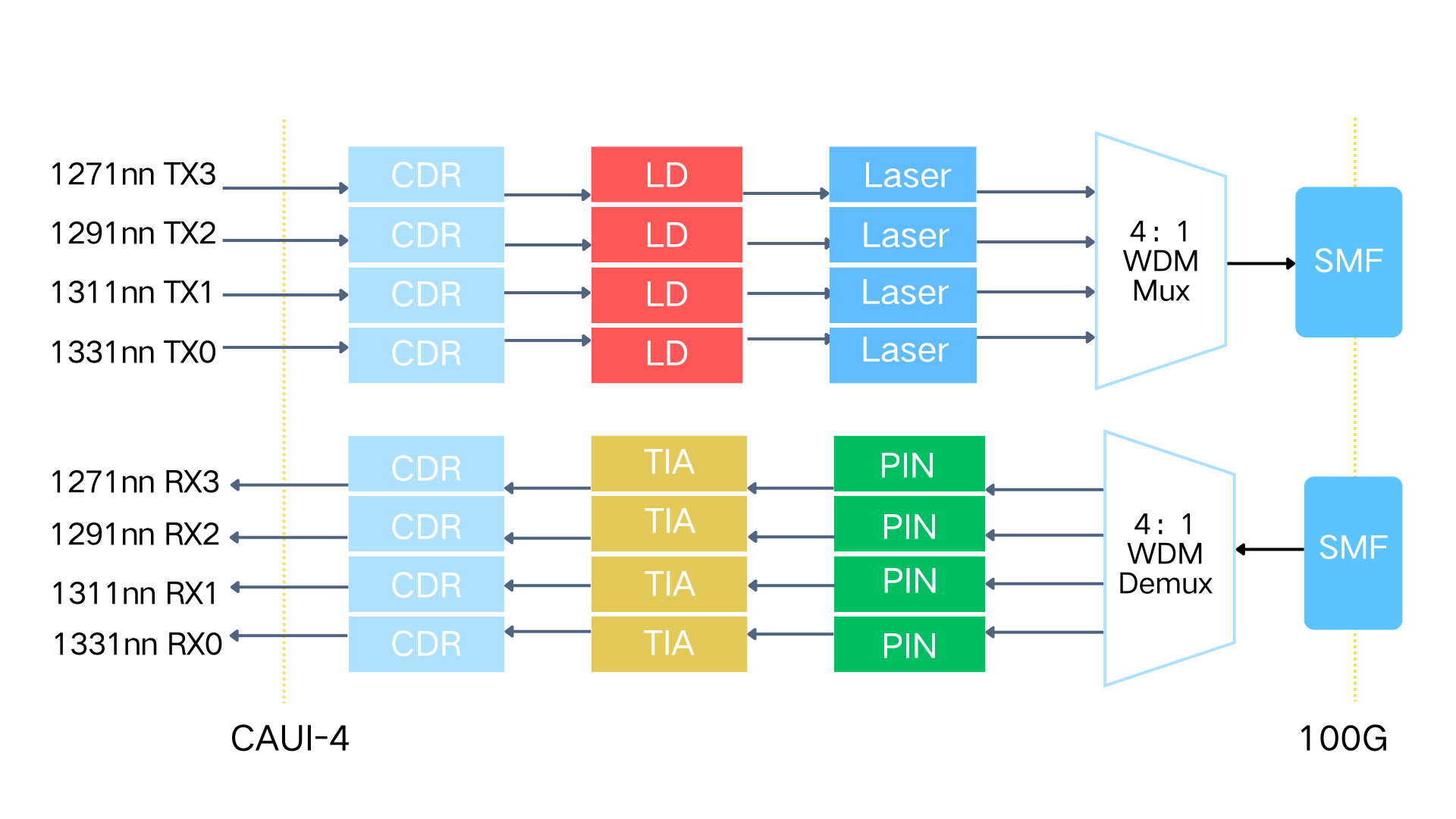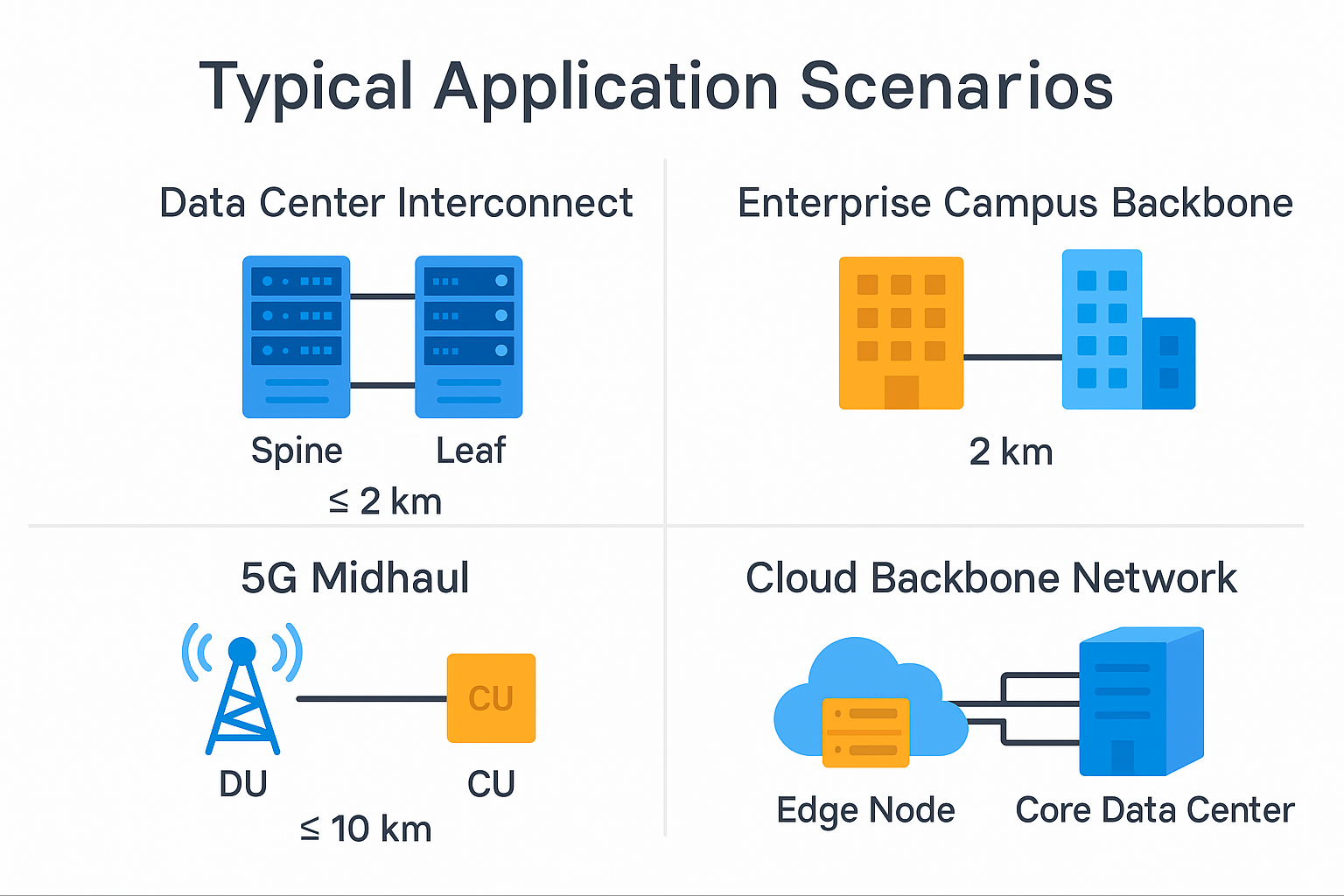The 100G QSFP28 CWDM4 optical module is a high-performance, cost-effective solution for short-to-medium distance interconnects in modern data centers, enterprise campus networks, 5G midhaul, and cloud backbone networks. Leveraging coarse wavelength division multiplexing (CWDM) technology, it achieves 100Gbps transmission over single-mode fiber with low latency, reduced power consumption, and simplified fiber infrastructure, making it an ideal choice for next-generation high-bandwidth applications.
100G QSFP28 CWDM4 is a 100Gbps optical transceiver based on Coarse Wavelength Division Multiplexing (CWDM) technology. It adopts the QSFP28 form factor and transmits data over single-mode fiber via four 25Gbps optical channels, with a typical reach of 2 km and a duplex LC interface. Compliant with CWDM4 MSA and IEEE 802.3ba 100G CWDM4 standards, it is widely used in data center interconnect (DCI) and high-performance computing (HPC) networks.

The 100G QSFP28 CWDM4 optical transceiver uses Coarse Wavelength Division Multiplexing (CWDM) technology to convert four 25G NRZ electrical signals into four optical signals of different wavelengths, multiplex them onto a single optical fiber, and achieve a total bandwidth of 100Gbps.
The core of CWDM4 is to multiplex four wavelengths over a single fiber, thereby reducing the number of fibers required while maintaining high-speed transmission. The process can be divided into the Transmit (Tx) and Receive (Rx) sections. The working procedures of the Tx and Rx in the 100G QSFP28 CWDM4 module are as follows:
On the transmit (Tx) side, the host device (switch/router) inputs four 25G NRZ electrical signals compliant with the CAUI-4 standard via the QSFP28’s 38-pin electrical interface, with each signal corresponding to an independent channel (Channel 1–4). These electrical signals respectively drive four uncooled directly modulated DFB lasers (DML), generating optical signals at four distinct wavelengths: 1271 nm, 1291 nm, 1311 nm, and 1331 nm. The CWDM multiplexer (MUX) then combines these four optical signals into a single output, which is transmitted through the Tx port of the duplex LC interface onto a single-mode fiber.
On the receive (Rx) side, the multiplexed optical signal from the fiber enters the module via the Rx port of the duplex LC interface and is separated by the CWDM demultiplexer (DEMUX) into the four original wavelength signals. Each optical signal is converted into a 25G electrical signal by a PIN photodiode (with a receiver sensitivity of ≤ –12 dBm, requiring FEC to achieve 2 km transmission) and is finally output to the host device through the QSFP28 electrical interface.

In short-to-medium reach applications within 2 km, 100G QSFP28 CWDM4 often offers greater advantages over 100G QSFP28 LR4, primarily in terms of cost, power consumption, and performance alignment. CWDM4 adopts an uncooled DFB laser design combined with coarse wavelength division multiplexing (CWDM) technology, resulting in lower component costs and reduced manufacturing complexity compared to the EML lasers and high-precision multiplexers required by LR4. This translates into a typical module cost savings of 30–40%.
In terms of power consumption, CWDM4 operates at around 3.5 W, compared to approximately 4.5 W for LR4, which significantly reduces overall data center energy usage and cooling requirements in large-scale deployments. Moreover, CWDM4 is specified for a 2 km reach (with FEC), which is sufficient for most Spine–Leaf architecture interconnects and inter-floor links in data centers, avoiding the cost and energy overhead of LR4’s extended 10 km reach where such capability is not needed. As a result, CWDM4 represents an optimal balance of performance, cost, and energy efficiency for data center and campus network environments where link distances are predictable and within 2 km.
Product specifications
| Parameter | Specification |
|---|---|
| Form Factor | QSFP28 (Quad Small Form-factor Pluggable 28) |
| Data Rate | 4 × 25Gbps NRZ, total 100Gbps |
| Wavelengths | 1271nm, 1291nm, 1311nm, 1331nm (±6.5nm) |
| Optical Fiber Type | Single-mode fiber (SMF) |
| Transmission Distance | Up to 2 km (with FEC) |
| Transmitter Type | Uncooled DFB laser (DML) |
| Receiver Type | PIN photodiode |
| Power Consumption | ≤ 3.5W |
| Compliance | CWDM4 MSA, IEEE 802.3bm, RoHS |
| Connector Type | Duplex LC |
| Digital Diagnostics | Supported, via I²C (DDM/DOM) |
Lower Fiber Infrastructure Cost
The module adopts a duplex LC interface, requiring only a single pair of single-mode fibers (SMF) to achieve bidirectional 100G transmission. This reduces fiber resource usage and simplifies cabling. For inter-rack or inter–data hall connections in data centers, it enables high-speed capacity upgrades without incurring additional fiber deployment costs.
Standards-based & Highly Compatible
Compliant with CWDM4 MSA and IEEE 802.3bm standards, the module can interoperate with similar products from different brands and manufacturers. This avoids the vendor lock-in risk associated with proprietary interfaces and allows flexible network equipment selection and future scalability.
Energy-Efficient Operation
With a typical power consumption of about 3.5W—significantly lower than some LR4 modules—it helps reduce overall energy usage and cooling pressure in data centers, lessens the load on cooling systems, and ultimately lowers long-term operational and maintenance costs.
Cost-effective for Short-to-Medium Reach
Delivers excellent performance and stability over transmission distances up to 2 km. Considering equipment, fiber, and power consumption costs, its overall investment is lower than that of LR4 modules for the same reach, making it an economical choice for cloud computing, enterprise data centers, and high-performance computing networks.

The 100G QSFP28 CWDM4 module is well-suited for data center interconnect (DCI) applications, including connections within a Spine–Leaf architecture and inter–data hall links within the same city or campus, with typical link lengths ranging from several hundred meters to 2 km.
Compared with 100G-LR4 (10 km) modules, CWDM4 offers notable advantages in both cost and power consumption, while its 2 km transmission capability fully meets the majority of short-to-medium distance DCI requirements.
In addition, compared with 100G-PSM4 solutions that require 8-fiber parallel SMF, CWDM4 uses only duplex LC single-mode fiber, significantly reducing fiber cabling resources and simplifying fiber management in the data center.
This makes it an ideal choice for large-scale data hall interconnect upgrades, delivering the required bandwidth while controlling both CAPEX and OPEX.
The 100G QSFP28 CWDM4 module is ideal for enterprise campus backbone networks, connecting headquarters with branch offices across large campuses, multi-building complexes, or across city blocks. Its 2 km transmission reach covers most backbone link distances without the need for additional optical amplifiers or repeaters.
Compared to traditional 40G QSFP+ LR4 modules, it offers a 2.5× increase in bandwidth, supporting high-bandwidth applications such as video conferencing, massive data transfers, and virtual desktop infrastructure (VDI). This makes it an excellent solution for enterprises aiming to rapidly upgrade their network backbone to 100G while maintaining cost-effectiveness and strong compatibility.
5G Midhaul
The 5G midhaul network is utilized for the fiber optic connection between the Distributed Unit (DU) and the Centralized Unit (CU) in 5G networks, meeting the midhaul link requirements defined by 3GPP. It supports transmission distances of up to 10 km (with Forward Error Correction, FEC) while fulfilling the latency and reliability demands of 5G midhaul networks.
Compared to the 25G SFP28 single-channel solution, it offers four times the bandwidth, enabling support for higher-density 5G cells and a broader range of services. This solution delivers significant value by providing a high-bandwidth upgrade to the 5G transport network while maintaining controlled link latency.
The Cloud Backbone Network is designed for high-speed interconnections between edge nodes and core data centers for cloud service providers (CSPs) such as AWS, Azure, and Google Cloud. It offers ultra-low latency (typically <1 μs), meeting the demands of latency-sensitive applications like distributed computing, real-time data analytics, and AI inference.
Utilizing standard LC single-mode fiber interfaces, it seamlessly integrates with existing fiber cabling systems, eliminating the need for extensive infrastructure upgrades. This solution delivers significant value by providing a stable, high-bandwidth, and low-latency transmission link, enabling rapid deployment of cloud services and edge computing.
In summary, the 100G QSFP28 CWDM4 module delivers an optimal balance of performance, cost, and energy efficiency for 2 km transmission scenarios. Its compatibility with industry standards, low fiber requirements, and support for diverse applications—ranging from data center interconnects to 5G and cloud networks—position it as a versatile and economical solution for upgrading high-speed network infrastructure.
A: No. The dispersion effect over single-mode fiber within 2 km is negligible (D ≤ 17 ps/nm·km).
A: No. CWDM wavelengths (1271–1331 nm) do not overlap with the DWDM C-band (1530–1565 nm).
A: You can fill these bottles with numerous types of spirits, including whiskey, vodka, rum, gin, and liqueurs. The 50 ml size is perfect for providing guests with a sample of your favorite drinks. Just ensure that the proof of the liquor is compatible with the bottle material (glass or plastic) you choose.
A: Yes. It complies with the QSFP28 MSA hot-plug standard.